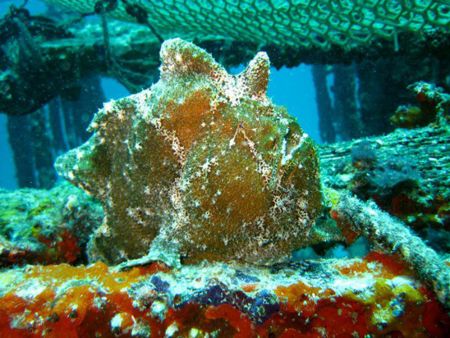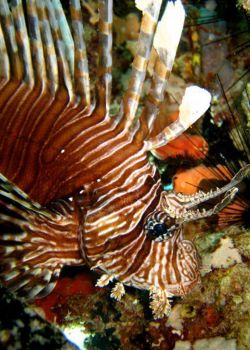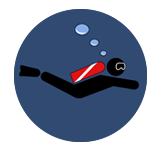Koh Haa Lagoon is situated in front of Koh Haa 3, the biggest of the five uninhabited limestone islands. As its name suggests, it’s in a bay or lagoon and has clear waters lapping a pristine sandy beach. The water starts at ankle depth and gradually slopes away into deeper but still calm waters, leading to coral bommies and a reef which are a wonderful place for easy scuba diving. However, the marine life here is extremely healthy, diverse and interesting, especially the small fish and invertebrates. While conditions are suitable for snorkellers and novice divers, it does not mean that experienced and even professional divers will find The Lagoon boring or too easy.  Frogfish (Antennariidae) Photo By Emmy AhlénIn fact, it is a favourite spot for underwater photographers. They like to find and photograph small creatures and need calm waters and plenty of light. These shallow waters full of healthy corals and protected by the island’s bay make the site perfect for such photography. Even those not new to diving or interested in photography can enjoy a really good dive here. The sea conditions allow for a diver’s air supply to last much longer than at deeper dive sites or those with a current. Therefore, anyone can lazily float around The Lagoon, searching the corals for something interesting or just enjoying the wonderful colours all around.
Frogfish (Antennariidae) Photo By Emmy AhlénIn fact, it is a favourite spot for underwater photographers. They like to find and photograph small creatures and need calm waters and plenty of light. These shallow waters full of healthy corals and protected by the island’s bay make the site perfect for such photography. Even those not new to diving or interested in photography can enjoy a really good dive here. The sea conditions allow for a diver’s air supply to last much longer than at deeper dive sites or those with a current. Therefore, anyone can lazily float around The Lagoon, searching the corals for something interesting or just enjoying the wonderful colours all around.
It’s difficult to know where to start when describing this fantastic diving and snorkelling site. It’s a shame that the area is normally closed to the public during the rainy season, as the conditions at this particular spot are consistently good all year round. However, until the local authorities change their minds (something that has been rumoured to happen) the Koh Haa archipelago is only open for the months between October and May.
The beach at The Lagoon on Koh 3 faces east and anyone on the beach will enjoy looking out at a couple of limestone islets. All five of these islands at Koh Haa are uninhabited, and remain both natural and beautiful. The two smaller islands are Koh Haa 2 and Koh Haa 4, which is where the deeper waters of The Lagoon are to be found. The northern of the two mini islands is Koh Haa 2 and to its south, Koh Haa 4. Around these are wonderful diving sites, famous for their crystal-clear waters and the ability to dive deep, then ascend up to the surface while enjoying healthy and diverse marine life.
Koh Haa 2 offers depths to around 30m on its east side with Koh Haa 4 deeper but divers need to venture away from the island to do so. The dive site is a very popular place for all levels of certified diver. At times when there are currents, divers can find shelter behind the island’s limestone walls, but Koh Lanta dive centre’s Divemasters and tour leaders will always plan the dive to maximize time and enjoyment under the surface of the water. Generally, the conditions around Koh Haa 2 are not too challenging and the dive site can be enjoyed at a relaxed pace in one dive, or divers can start or finish at Koh Haa 4, just a short swim to the south. In fact, some Divemasters are able to take advantage of favourable conditions and swim a figure-of-8 around Islands 2 & 4 in one dive, but doing so may cause some of the smaller species to be missed. The typical marine life to be found at these two islets in front of The Lagoon is what divers come here to see.
 Lionfish (Pterois) Photo by Emmy AhlénSmall species are really what The Lagoon is all about. The largest creatures to be found here are mid-sized reef and pelagic fishes, plus the occasional Hawksbill Turtle (Eretmochelys imbricata). However, in among the nooks and crannies there are lots of very interesting critters, including bony fish and crustaceans. Ornate / Harlequin Ghost Pipefish (Solenostomus paradoxus) is probably the most sought-after of these, as it is extremely beautiful and intricate. Luckily for those who have found it and want to show others or return on the next dive, these fish don’t tend to move around much. The same can be said for Frogfish (Antennariidae), which are equally difficult to spot, even when another diver is pointing directly at it. Easier to see, are the hundreds of species of small reef fish here at Koh Haa Lagoon. Porcupine Pufferfish (Diodon holocanthus) are quite common, but still tend to be popular with many divers. Venomous Lionfish (Pterois) and Scorpionfish (Scorpaenidae) are easy and hard to see, respectively. Finally for the fish, there is Nemo, using sea anemones for protection from predators. Of course, Nemo is not the species, it is in fact a Clown (or Orange) Anemonefish depending on who you want to believe (Amphiprion ocellaris / percula).
Lionfish (Pterois) Photo by Emmy AhlénSmall species are really what The Lagoon is all about. The largest creatures to be found here are mid-sized reef and pelagic fishes, plus the occasional Hawksbill Turtle (Eretmochelys imbricata). However, in among the nooks and crannies there are lots of very interesting critters, including bony fish and crustaceans. Ornate / Harlequin Ghost Pipefish (Solenostomus paradoxus) is probably the most sought-after of these, as it is extremely beautiful and intricate. Luckily for those who have found it and want to show others or return on the next dive, these fish don’t tend to move around much. The same can be said for Frogfish (Antennariidae), which are equally difficult to spot, even when another diver is pointing directly at it. Easier to see, are the hundreds of species of small reef fish here at Koh Haa Lagoon. Porcupine Pufferfish (Diodon holocanthus) are quite common, but still tend to be popular with many divers. Venomous Lionfish (Pterois) and Scorpionfish (Scorpaenidae) are easy and hard to see, respectively. Finally for the fish, there is Nemo, using sea anemones for protection from predators. Of course, Nemo is not the species, it is in fact a Clown (or Orange) Anemonefish depending on who you want to believe (Amphiprion ocellaris / percula).
There are several species of eels at The Lagoon. These include larger species (Moray Eels) which live alone and generally spend their days hiding, but have been seen swimming freely across the reef here in daylight. There are also lots and lots of Garden Eels (Heteroconger hassi), which live in large groups in individual holes in the sandy seabed. When approached they will all disappear into their holes, re-emerging when they feel that the coast is clear. Divers wanting to see them after they have hidden need only wait patiently and still to the side of the sandy patch and they will soon return to view and dance around catching microscopic morsels in the current.
Crustaceans are also very popular here and The Lagoon, Koh Haa. In particular, Mantis Shrimps (Stomatopoda) and the Harlequin Shrimp (Hymenocera picta). There is a chance of seeing squid or octopuses here, as well, with the squid swimming away from divers and octopuses normally hiding with camouflage before they’re even spotted.
Overall, this is a very popular spot for everyone who comes to Koh Haa. From the moment the boat slowly approaches the bay the exquisite beauty has first time visitors in awe and still brings a smile to the faces of regulars. There’s something to do for everyone, especially scuba divers. It’s easy enough to enjoy a good long dive here, and is ideal preparation for the deeper and more challenging dives around this mini archipelago.

